// Here is the Arduino code that I used.
// Open up the Arduino environment. Then copy and paste it into a new sketch.
// Then upload the code to the Arduino board.
#include
Servo myservo; //create servo object to control a servo
int ResetTimer=0; //sets delay to reset position
int GoalPosition=3; //stores the goal postion (1-5) where the person is standing
int GoalPositionDegrees; //stores the goal position in degrees (30-150)
int CurrentPositionDegrees=90; //stores the current position in degrees (30-150)
int AveragingSpeed=100; //sets how quickly the average values adjust (a lower value changes average value quickly) //quickly. A value of 100 changes the average value slowly
// his effectively sets the speed at which the sensors recalibrate themselves to changing light conditions
int PinOneCurrent; //stores current value of pins 1-5
int PinTwoCurrent;
int PinThreeCurrent;
int PinFourCurrent;
int PinFiveCurrent;
float PinOneAverage; //stores the average value of pins 1-5
float PinTwoAverage;
float PinThreeAverage;
float PinFourAverage;
float PinFiveAverage;
float RatioPinOne=0.00; //stores the ratio of current pin value to average pin value
float RatioPinTwo=0.00;
float RatioPinThree=0.00;
float RatioPinFour=0.00;
float RatioPinFive=0.00;
float Threshold=0.95; //sets minimum threshold for sensors
void setup()
{
myservo.attach(13); //attaches servo to digital pin 13
PinOneAverage = analogRead(1); //reads from sensors to set initial average pin value
PinTwoAverage = analogRead(2);
PinThreeAverage = analogRead(3);
PinFourAverage = analogRead(4);
PinFiveAverage = analogRead(5);
}
void loop()
{
//read analog pins 1-5 and set the result as current value
PinOneCurrent= analogRead(1);
PinTwoCurrent= analogRead(2);
PinThreeCurrent= analogRead(3);
PinFourCurrent= analogRead(4);
PinFiveCurrent= analogRead(5);
//adjust average pin values
PinOneAverage=PinOneAverage+(PinOneCurrent-PinOneAverage)/AveragingSpeed;
PinTwoAverage=PinTwoAverage+(PinTwoCurrent-PinTwoAverage)/AveragingSpeed;
PinThreeAverage=PinThreeAverage+(PinThreeCurrent-PinThreeAverage)/AveragingSpeed;
PinFourAverage=PinFourAverage+(PinFourCurrent-PinFourAverage)/AveragingSpeed;
PinFiveAverage=PinFiveAverage+(PinFiveCurrent-PinFiveAverage)/AveragingSpeed;
//calculates ratio of current pin value to average pin value
RatioPinOne=(float)PinOneCurrent/PinOneAverage;
RatioPinTwo=(float)PinTwoCurrent/PinTwoAverage;
RatioPinThree=(float)PinThreeCurrent/PinThreeAverage;
RatioPinFour=(float)PinFourCurrent/PinFourAverage;
RatioPinFive=(float)PinFiveCurrent/PinFiveAverage;
//determine which ratio is the largest and sets the goal position
//set goal position
if (RatioPinThree < Threshold && RatioPinThree < RatioPinOne && RatioPinThree < RatioPinTwo && RatioPinThree < RatioPinFour && RatioPinThree < RatioPinFive)
{ GoalPosition=3;
ResetTimer=0; }
else if (RatioPinOne < Threshold && RatioPinOne < RatioPinTwo && RatioPinOne < RatioPinThree && RatioPinOne < RatioPinFour && RatioPinOne < RatioPinFive)
{ GoalPosition=1;
ResetTimer=0; }
else if (RatioPinTwo < Threshold && RatioPinTwo < RatioPinOne && RatioPinTwo < RatioPinThree && RatioPinTwo < RatioPinFour && RatioPinTwo < RatioPinFive)
{ GoalPosition=2;
ResetTimer=0; }
else if (RatioPinFour < Threshold && RatioPinFour < RatioPinOne && RatioPinFour < RatioPinTwo && RatioPinFour < RatioPinThree && RatioPinFour < RatioPinFive)
{ GoalPosition=4;
ResetTimer=0; }
else if (RatioPinFive < Threshold && RatioPinFive < RatioPinOne && RatioPinFive < RatioPinTwo && RatioPinFive < RatioPinThree && RatioPinFive 100) //after delay resets to position 3
{ GoalPosition=3;
ResetTimer=0; }
else
{ ResetTimer=ResetTimer+1; }
GoalPositionDegrees=GoalPosition*25+15; //converts the goal position to degrees
myservo.write(GoalPositionDegrees); //sets the servo position according to the scaled value
delay(30); //sets how quckly the servo turns (lower numbers turn more quickly)
}


